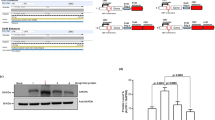Abstract
The OCTN2 cDNA amplified from human skin fibroblast was cloned in pET-41a(+) carrying the glutathione S-transferase (GST) gene. The construct pET-41a(+)–hOCTN2 was used to express the GST–hOCTN2 fusion protein in Escherichia coli Rosetta(DE3)pLysS. The best over-expression was obtained after 6 h of induction with IPTG at 28°C. The GST–hOCTN2 polypeptide was collected in the inclusion bodies and showed an apparent molecular mass on SDS-PAGE of 85 kDa. After solubilization with a buffer containing 0.8% sarkosyl and 3 M urea, the fusion protein was applied onto a Ni2+-chelating chromatography column. The purified GST–hOCTN2 was treated with thrombin, and the hOCTN2 was separated from the GST by size exclusion chromatography. After the whole procedure, a yield of about 0.2 mg purified protein per liter of cell culture was obtained. To improve the protein yield, hOCTN2 cDNA was subjected to codon bias. The second codon CGG was substituted with AAA; the substitution led to the mutation R2K in the hOCTN2 protein. hOCTN2(R2K) cDNA was cloned in pET-21a(+) carrying a C-terminal 6His tag. The resulting protein was expressed in E. coli Rosetta(DE3)pLysS and purified by Ni2+-chelating chromatography. A yield of about 3.5 mg purified protein per liter of cell culture was obtained with this procedure.





Similar content being viewed by others
References
Wallin, E., & von Heijne, G. (1998). Genome-wide analysis of integral membrane proteins from eubacterial, archaean, and eukaryotic organisms. Protein Science, 7, 1029–1038.
Palacin, M., Estevez, R., Bertran, J., & Zorzano, A. (1998). Molecular biology of mammalian plasma membrane amino acid transporters. Physiological Reviews, 78, 969–1054.
Lahjouji, K., Mitchell, G. A., & Qureshi, (2001). Carnitine transport by organic cation transporters and systemic carnitine deficiency. Molecular Genetics and Metabolism, 73, 287–297.
Daniel, H., & Kottra, G. (2004). The proton oligopeptide cotransporter family SLC15 in physiology and pharmacology. Pflugers Archiv, 447, 610–618.
Wright, E. M., & Turk, E. (2004). The sodium/glucose cotransport family SLC5. Pflugers Archiv, 447, 510–518.
Bröer, A., Cavanaugh, J. A., Rasko, J. E., & Bröer, S. (2006). The molecular basis of neutral aminoacidurias. Pflugers Archiv, 451, 511–517.
Palmieri, F. (2008). Diseases caused by defects of mitochondrial carriers: A review. Biochimica et Biophysica Acta, 1777, 564–578.
Tate, C. G. (2001). Overexpression of mammalian integral membrane proteins for structural studies. FEBS Letter, 504, 94–98.
Galluccio, M., Pochini, L., Amelio, L., Accardi, R., Tommasino, M., & Indiveri, C. (2009). Over-expression in E. coli and purification of the human OCTN1 transport protein. Protein Expression and Purification, 68, 215–220.
Tamai, I., Ohashi, R., Nezu, J. I., Sai, Y., Kobayashi, D., Oku, A., et al. (2000). Molecular and functional characterization of organic cation/carnitine transporter family in mice. The Journal of Biological Chemistry, 275, 40064–40072.
Lahjouji, K., Malo, C. K., Mitchell, G. A., & Qureshi, I. A. (2002). l-Carnitine transport in mouse renal and intestinal brush-border and basolateral membrane vesicles. Biochimica et Biophysica Acta, 1558, 82–93.
Tamai, I., Ohashi, R., Nezu, J., Yabuuchi, Y., Oku, A., Shimane, M., et al. (1998). Molecular and functional identification of sodium independent, high affinity human carnitine transporter OCTN2. The Journal of Biological Chemistry, 273, 20378–20382.
Pochini, L., Oppedisano, F., & Indiveri, C. (2004). Reconstitution into liposomes and functional characterization of the carnitine transporter from renal cell plasma membrane. Biochimica et Biophysica Acta, 1661, 78–86.
Pochini, L., Scalise, M., & Indiveri, C. (2009). Inactivation by omeprazole of the carnitine transporter (OCTN2) reconstituted in liposomes. Chemico-Biological Interactions, 179, 394–401.
Wu, X., Huang, W., Prasad, P. D., Seth, P., Rajan, D. P., Leibach, F. H., et al. (1999). Functional characteristics and tissue distribution pattern of organic cation transporter 2 (OCTN2), an organic cation/carnitine transporter. Journal of Pharmacology and Experimental Therapeutics, 290, 1482–1492.
Cohen, S. N., Chang, A. C., & Hsu, L. (1972). Nonchromosomal antibiotic resistance in bacteria: Genetic transformation of Escherichia coli by R-factor DNA. The Proceedings of the National. Academy of Sciences of United States of America, 69, 2110–2114.
Dulley, J. R., & Grieve, P. A. (1975). A simple technique for eliminating interference by detergents in the Lowry method of protein determination. Analytical Biochemistry, 64, 136–141.
Laemmli, U. K. (1970). Cleavage of structural proteins during the assembly of the head of bacteriophage T4. Nature, 227, 680–685.
Niimura, Y., Terabe, M., Gojobori, T., & Miura, K. (2003). Comparative analysis of the base biases at the gene terminal portions in seven eukaryote genomes. Nucleic Acids Research, 31, 5195–5201.
Author information
Authors and Affiliations
Corresponding author
Rights and permissions
About this article
Cite this article
Galluccio, M., Amelio, L., Scalise, M. et al. Over-Expression in E. coli and Purification of the Human OCTN2 Transport Protein. Mol Biotechnol 50, 1–7 (2012). https://doi.org/10.1007/s12033-011-9406-6
Published:
Issue Date:
DOI: https://doi.org/10.1007/s12033-011-9406-6




